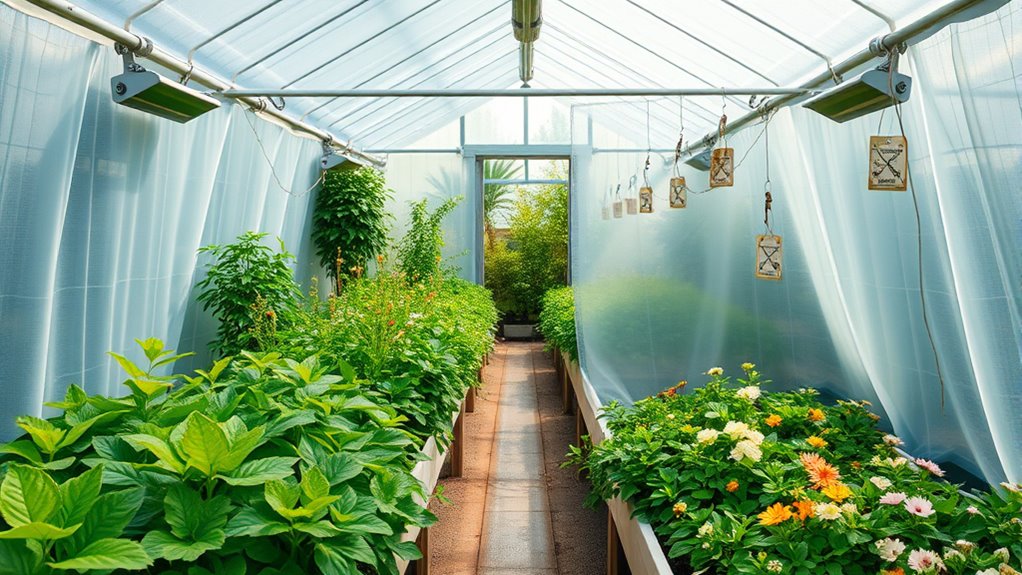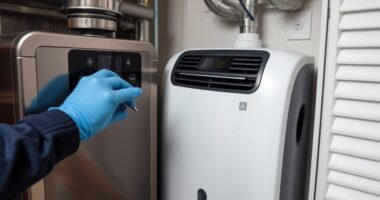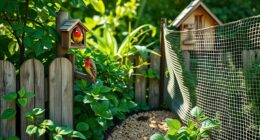To pest-proof your greenhouse, start with thorough inspections of all plants, soil, and surfaces to catch issues early. Install physical barriers like fine mesh screens over vents and doorways while maintaining good hygiene by removing debris and sterilizing tools. Choose pest-resistant plant varieties and manage environmental factors such as humidity and temperature to deter pests. Encourage natural predators and use organic controls for added protection. For a complete approach, explore further strategies to keep pests out effectively.
Key Takeaways
- Conduct regular inspections and keep detailed pest activity logs for early detection and targeted intervention.
- Install physical barriers like mesh screens and seal entry points to prevent pest ingress.
- Enhance habitat diversity with companion planting and shelters to attract natural predators and reduce pest populations.
- Maintain optimal environmental conditions by controlling humidity, temperature, and light to deter pests.
- Practice sanitation and select pest-resistant plant varieties to strengthen plants’ natural defenses against infestations.
Conducting a Thorough Greenhouse Inspection
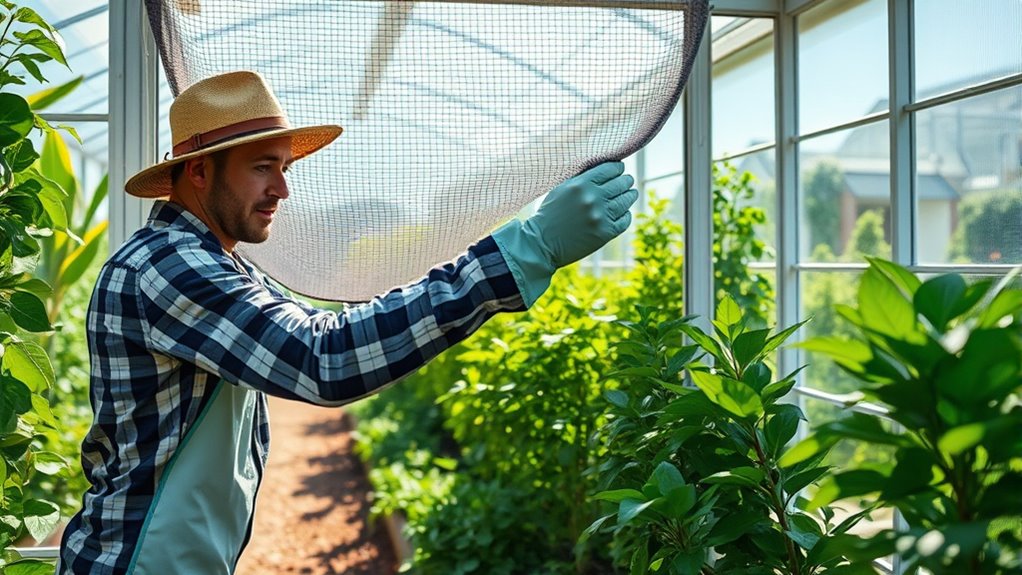
Before pests can invade your greenhouse, a thorough inspection is essential. Begin by carefully examining all plant surfaces, focusing on leaves, stems, and soil. Look for signs of pest activity, such as chewed leaves, sticky residues, or webbing. Regular inspections are a key part of preventative pest management and help maintain a healthy environment for your plants. Accurate pest identification helps determine which pests are present and the best control methods. Keep detailed records of your findings, noting pest types, locations, and infestation severity. Record keeping creates a baseline for monitoring pest populations over time and evaluating the effectiveness of your pest management strategies. Regular inspections allow you to catch problems early, preventing minor issues from escalating. Being diligent and systematic in your inspection process guarantees you stay ahead of potential pest invasions, protecting your greenhouse’s health and productivity. Incorporating proper pest control methods and maintaining a clean environment further enhances your pest-proofing efforts. Additionally, understanding the specific pests that commonly affect greenhouse plants can help you tailor your prevention tactics more effectively and utilize integrated pest management strategies for sustainable control. Moreover, staying informed about regional pest statistics can help anticipate which pests are most likely to invade your greenhouse and prepare accordingly.
Implementing Physical Barriers and Screens
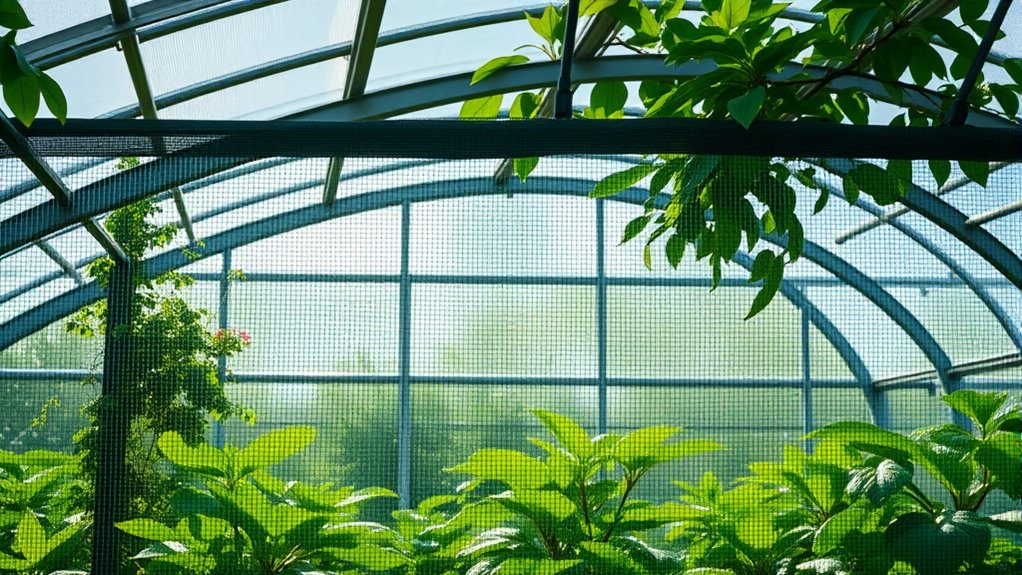
Implementing physical barriers and screens is one of the most effective ways to prevent pests from entering your greenhouse. You can install mesh screens over vents, windows, and doorways to block insects while allowing airflow. Use durable, fine mesh to keep out tiny pests like aphids and whiteflies. Properly chosen wicking materials can also assist in maintaining a healthy environment by reducing excess moisture that attracts pests. Physical barriers, such as sealing gaps around doors and windows, further reduce entry points. Ensuring proper self watering plant pots placement and maintenance can also help prevent excess moisture buildup that attracts pests. Installing mesh screens not only protects your plants but also minimizes the need for chemical controls. Additionally, employing integrated pest management strategies can enhance your overall pest prevention efforts. Incorporating pest-resistant plant varieties can further strengthen your defenses by reducing vulnerability to common pests. Regular monitoring and early detection are crucial components of effective pest prevention to address infestations before they become severe. By creating a robust barrier system, you keep pests outside, maintain a healthier growing environment, and improve your greenhouse’s overall pest management strategy.
Maintaining Proper Hygiene and Sanitation
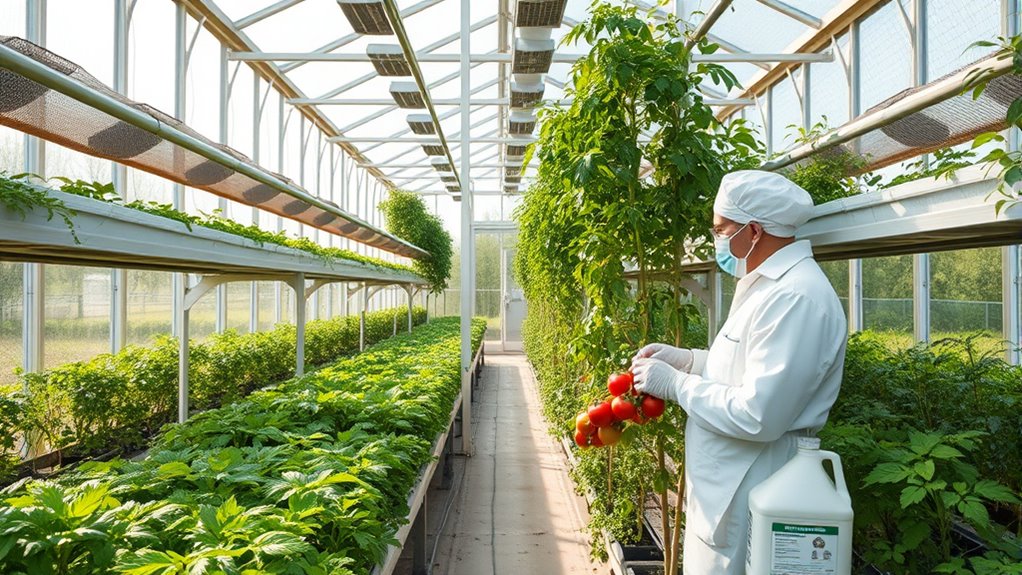
Maintaining proper hygiene and sanitation is essential for preventing pests from taking hold in your greenhouse. You should keep storage areas clean and organized, removing plant debris and old materials that attract pests. Regularly inspecting and cleaning your tools ensures you don’t transfer pests or diseases between plants. Always sterilize your tools after use with alcohol or a disinfectant, especially when switching between different plant species. Practice good sanitation by wiping down benches, shelves, and other surfaces frequently to eliminate pests and their eggs. Proper storage cleanliness reduces hiding spots for pests and helps maintain a healthy environment. Incorporating mindfulness techniques can also help you stay attentive to early signs of pest problems, allowing for prompt intervention and prevention. Regularly monitoring plant health and growth stages can help identify issues early before they escalate, making pest prevention more effective. Additionally, understanding local water park options can provide enjoyable ways to relax and take a break from gardening chores. Being aware of integrated pest management practices can further enhance your efforts to keep pests at bay through environmentally friendly methods.
Selecting Resistant Plant Varieties
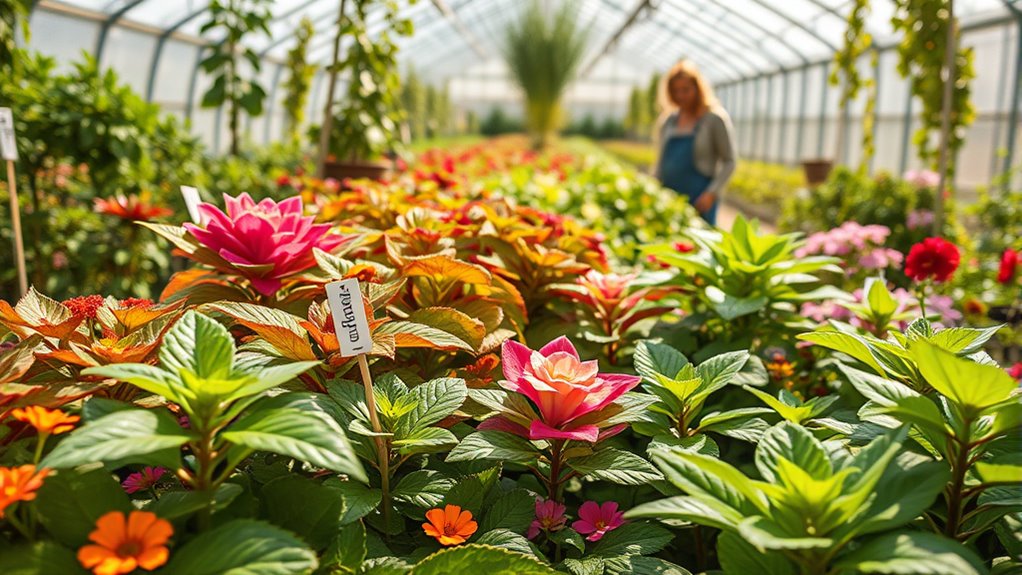
Choosing resistant plant varieties can markedly reduce pest problems in your greenhouse. By selecting cultivars bred for pest resistance, you’re more likely to see healthier plants with fewer treatments. Additionally, opting for local or region-specific varieties often offers better adaptation and natural pest defenses. This approach can also contribute to maintaining cultural heritage and upbringing, fostering a sustainable gardening environment. Incorporating integrated pest management strategies alongside resistant varieties can further enhance pest control effectiveness while minimizing chemical use. Selecting plants that thrive in your home environment can also help support overall plant health and resilience.
Resistant Cultivar Choices
Have you considered selecting plant varieties that are naturally resistant to pests? Choosing resistant cultivars can markedly reduce your need for chemical controls. By focusing on genetic resistance, you improve your chances of pest management success. When making your cultivar selection, look for varieties labeled as pest-resistant or with documented pest resistance. Incorporating resistance traits into your plant choices can further enhance your pest management strategy. Understanding plant immunity can also help you select the most resilient options for your greenhouse. For example, some cultivars have been bred to enhance pest resistance, making them even more effective in pest prevention.
Local Adaptation Benefits
Selecting plant varieties that are well-adapted to your local environment can considerably enhance their natural resistance to pests. When you choose plants suited to your local climate adaptation, they’re better equipped to handle regional pest trends, reducing the need for chemical interventions.
These varieties often develop stronger defenses naturally, making your greenhouse more resilient.
- They thrive in local conditions, requiring less maintenance
- They resist common pests specific to your region
- They grow more vigorously, outpacing pest damage
- They establish quicker, ensuring a healthier crop
Focusing on local adaptation ensures your plants are inherently more pest-resistant, saving you time and resources while promoting a sustainable, pest-proof greenhouse environment.
Managing Environmental Conditions

Maintaining ideal environmental conditions is essential for preventing pests from taking hold in your greenhouse. Proper humidity control helps reduce mold and fungal issues that attract pests, while also creating an unfavorable environment for insects.
Temperature regulation is equally critical; keeping temperatures consistent prevents stress in plants that pests exploit. Use fans, vents, or heaters to stabilize conditions, and monitor with reliable gauges.
Sudden shifts in humidity or temperature can weaken plants, making them more vulnerable to infestations. By actively managing these factors, you create a less inviting environment for pests and promote healthy plant growth.
Regular checks ensure that conditions stay within optimal ranges, helping you catch issues early before they evolve into serious problems.
Encouraging Natural Predators
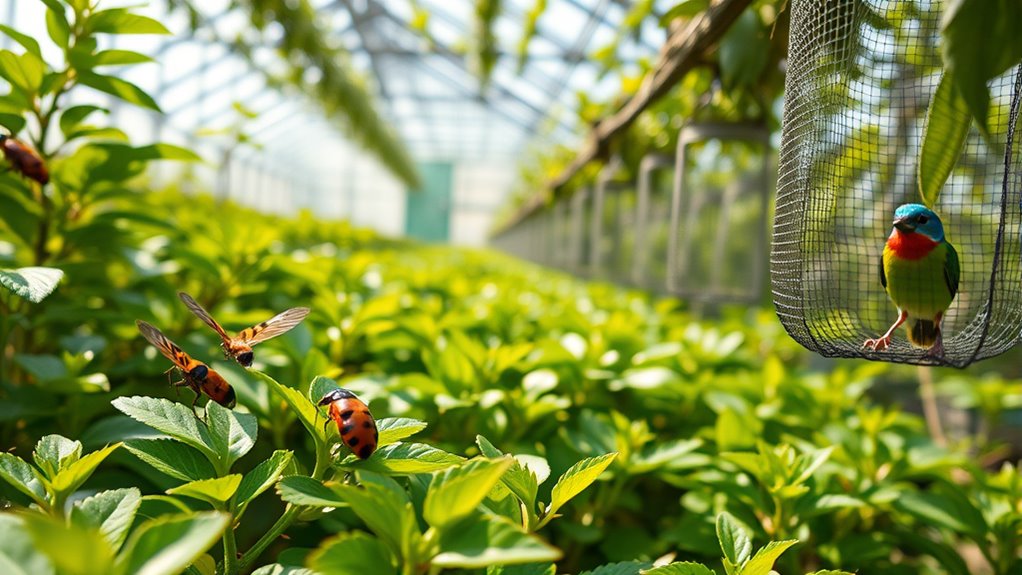
You can naturally control pests by attracting beneficial insects to your greenhouse. Using habitat enhancement techniques, you create a welcoming environment for predators like ladybugs and lacewings.
These helpful insects will actively hunt pests, reducing your need for chemical treatments.
Beneficial Insects in Action
Beneficial insects play a crucial role in naturally controlling pests within your greenhouse, reducing the need for chemical interventions. By supporting pollinator partnerships and insect habitat creation, you encourage beneficial insects like ladybugs, lacewings, and parasitic wasps to thrive.
These natural predators actively hunt and suppress pest populations, keeping your plants healthy. To maximize their effectiveness, consider planting diverse flowering plants that attract and sustain beneficial insects.
You can also introduce commercially available beneficial insects to jumpstart pest control. Remember, creating a habitat that supports these insects ensures they remain active and effective.
Engaging in pollinator partnerships and insect habitat creation helps maintain a balanced ecosystem, making pest management more sustainable and less reliant on chemicals.
Habitat Enhancement Techniques
Creating a supportive environment for natural predators is a key step in pest-proofing your greenhouse. You can achieve this by implementing habitat enhancement techniques that promote habitat diversity.
Incorporate companion planting to attract beneficial insects and natural predators, such as planting marigolds near tomatoes to lure predatory insects.
Providing shelter, like small shrubs or insect hotels, encourages predators to stay and thrive.
Avoid monoculture, which reduces habitat diversity and diminishes natural pest control. Instead, create layered plantings with a variety of flowers, herbs, and vegetables to support a broader range of beneficial insects.
These strategies make your greenhouse less inviting to pests and more welcoming to their natural enemies, creating a balanced ecosystem that helps keep pest populations in check naturally.
Using Organic Pest Control Methods
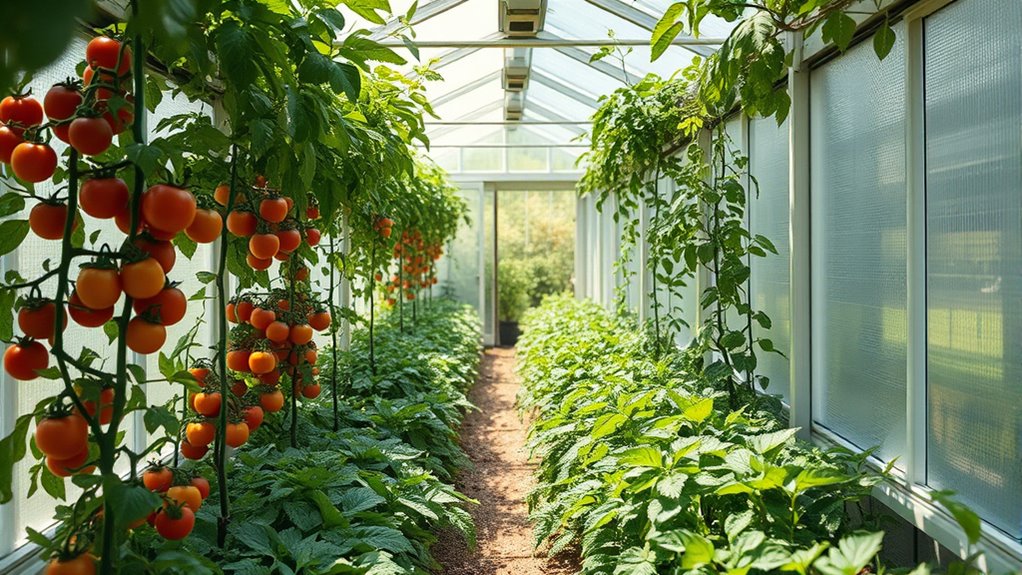
Organic pest control methods offer an effective and environmentally friendly way to protect your greenhouse crops. You can use natural solutions like compost teas and botanical extracts to deter pests without harmful chemicals.
Compost teas boost plant health and strengthen defenses against insects, while botanical extracts such as neem oil or insecticidal soaps directly target pests. These methods are safe for beneficial insects and your plants.
To maximize their effectiveness, apply treatments early in the morning or late in the evening. Regularly rotate different organic solutions to prevent pests from developing resistance.
Remember, consistency is key to maintaining a pest-free environment organically. Using these natural approaches helps you maintain healthy crops while minimizing ecological impact.
- Boost plant immunity with compost teas
- Use botanical extracts for targeted pest control
- Apply treatments during ideal times
- Rotate solutions to prevent resistance
Monitoring and Early Detection Techniques
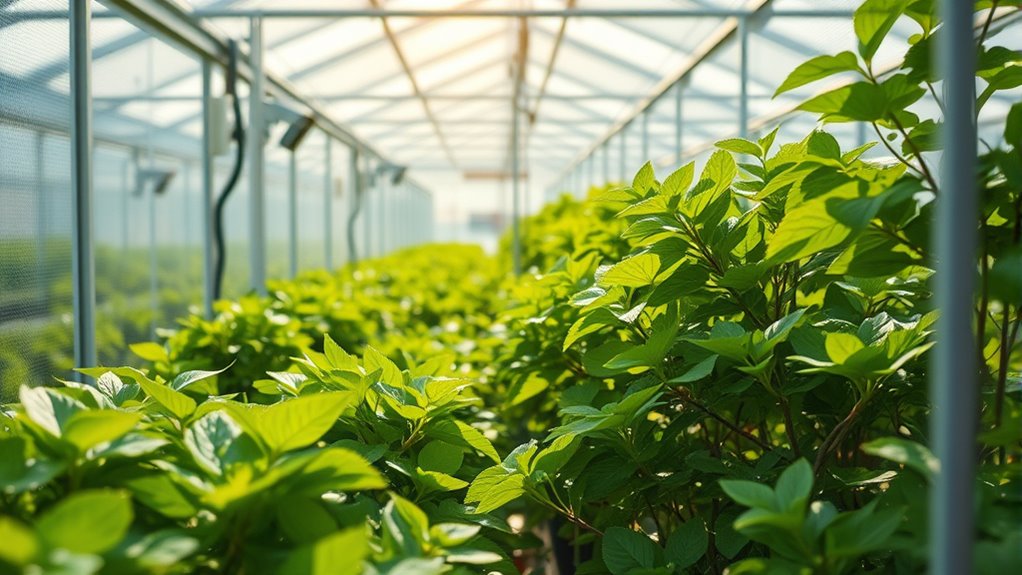
Effective monitoring and early detection are essential for preventing pest infestations before they become severe. Proper sensor placement allows you to identify pest activity quickly, so position sensors near entry points, vents, and suspected hotspots.
Regularly check pest activity logs to track patterns and identify emerging issues early. Using visual inspections alongside sensor data helps confirm pest presence and activity levels.
Keep detailed logs of pest sightings, damage, and environmental conditions to spot trends over time. This proactive approach helps you catch infestations early, making control efforts more effective and less disruptive.
Consistent monitoring creates a clear picture of pest behavior, enabling you to implement targeted interventions before pests establish a significant foothold in your greenhouse.
Regular Maintenance and Continual Assessment
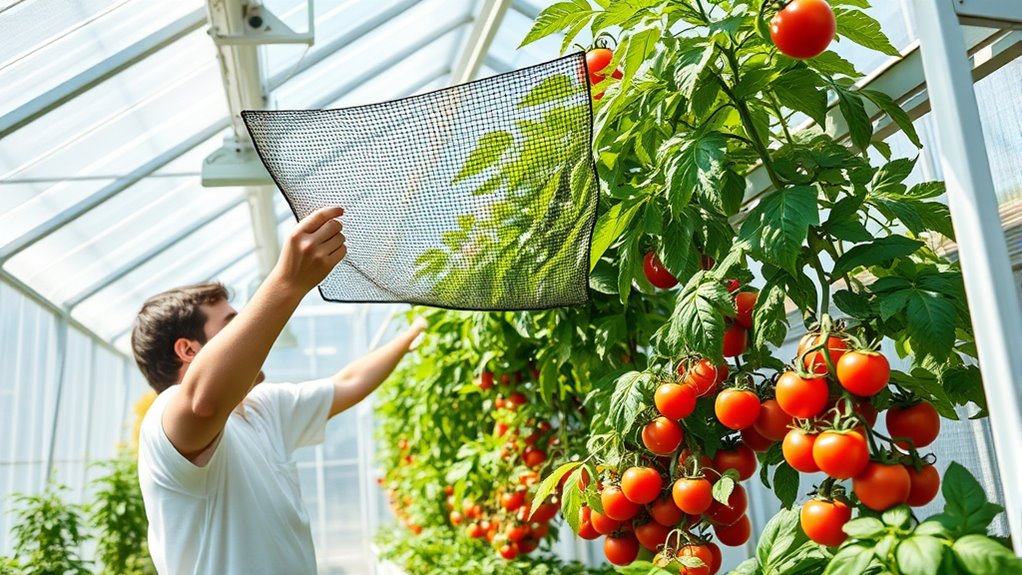
Regular maintenance and ongoing assessment are essential to keep your greenhouse pest-proof. Regularly inspect your structure for damage or wear, and apply pest resistant coatings to vulnerable areas.
Using automated pest detection systems helps identify issues early, so you can act swiftly. Consistent cleaning removes debris and potential hiding spots for pests.
Keep an eye on plant health to catch infestations before they spread.
- Schedule routine inspections for structural integrity and pest signs
- Reapply pest resistant coatings as needed
- Use automated pest detection to monitor activity continually
- Keep pathways and plant beds tidy to minimize pest habitats
Frequently Asked Questions
How Often Should I Perform Pest Inspections in My Greenhouse?
You should perform pest inspections regularly to keep your greenhouse healthy. An ideal inspection schedule involves checking your plants at least once a week, especially during peak growing seasons.
Consistent pest monitoring helps you catch problems early, preventing infestations from spreading. Keep an eye out for signs of pests or damage and adjust your inspection frequency based on your greenhouse’s specific conditions.
Regular inspections are key to maintaining a pest-free environment.
What Are the Most Common Pests Found in Greenhouses?
Like a thief in the night, pests can sneak into your greenhouse. You’ll often find aphids, whiteflies, spider mites, and fungus gnats lurking in plants or soil.
To keep them at bay, conduct pest identification and pest habitat analysis regularly. Spotting these common pests early helps you act swiftly, preventing infestations.
Can Pest-Proofing Methods Impact Plant Growth or Yield?
Pest-proofing impact can vary, but if you use proper methods, it generally benefits plant growth by reducing pest damage and disease spread. You might worry about restrictions or chemicals, but effective pest-proofing creates a healthier environment, promoting better yield.
When you implement physical barriers, sanitation, and integrated pest management, you support strong plant growth. So, pest-proofing doesn’t hinder; it enhances your greenhouse’s productivity and overall plant health.
Are There Eco-Friendly Options for Pest Eradication?
Think of eco-friendly pest control as a gentle breeze guiding away unwanted guests. You can use biological control, like releasing beneficial insects that target pests naturally, or apply natural repellents such as neem oil or garlic spray. These options are safe for your plants and the environment, allowing you to manage pests effectively without harmful chemicals.
Embracing eco-friendly methods helps protect your greenhouse ecosystem while keeping pests at bay.
How Do I Balance Pest Control With Beneficial Insect Preservation?
Balancing pest control with beneficial insect preservation involves using targeted methods like biological control and selective pesticides.
You can introduce natural predators to manage pests while avoiding harm to beneficial insects.
Selective pesticides specifically target pests without disrupting your helpful insects’ populations.
Conclusion
By diligently diagnosing and diligently defending, you can dramatically diminish pests and prevent problems before they proliferate. Consistent checks, careful cleanliness, and clever cultivation create a confident, pest-proof haven. Remember, prevention is powerful—practice proactive pest-proofing with persistence and patience. With mindful maintenance and meticulous monitoring, you’ll master your greenhouse’s health, ensuring lush, pest-free plants. Stay vigilant, stay vigilant, and enjoy a vibrant, victorious greenhouse garden all season long.
